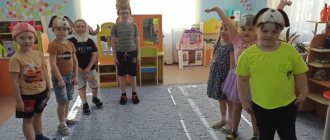Features of play activities of senior preschool age
At this stage of development of the game, word and deed come together, and role-playing behavior becomes a model of relationships between people that are meaningful to children. The stage of the actual role-playing game begins, in which the players simulate the labor and social relations of people familiar to them.
A scientific understanding of the stage-by-stage development of play activity makes it possible to develop clearer, systematized recommendations for guiding the play activities of children in different age groups.
In order to achieve a genuine, emotionally rich game, including an intellectual solution to a game problem, the teacher needs to comprehensively guide the formation, namely: purposefully enrich the child’s practical experience, gradually transferring it into a conventional game plan, and during independent games, encourage the preschooler to creatively reflect reality.
The game is dynamic where the management is aimed at its gradual formation, taking into account those factors that ensure the timely development of gaming activity at all age levels. Here it is very important to rely on the child’s personal experience. Game actions formed on its basis acquire a special emotional overtones. Otherwise, learning to play becomes mechanical. Emotions cement the game, make it exciting, create a favorable climate for relationships, increase the tone that every child needs - a share of his mental comfort, and this, in turn, becomes a condition for the preschooler’s receptivity to educational actions and joint activities with peers.
All components of a comprehensive guide to the formation of play are interconnected and equally important when working with children. As children grow older, the organization of their practical experience also changes, which is aimed at actively learning the real relationships between people in the process of joint activities. In this regard, the content of educational games and the conditions of the subject-game environment are updated. The emphasis of activating communication between adults and children shifts: it becomes businesslike, aimed at achieving joint goals. Adults act as one of the participants in the game, encouraging children to engage in joint discussions, statements, disputes, conversations, and contribute to the collective solution of game problems that reflect the joint social and labor activities of people.
So, the formation of play activities creates the necessary psychological conditions and favorable soil for the comprehensive development of the child. Comprehensive education of children, taking into account their age characteristics, requires systematization of the games used in practice, the establishment of connections between different forms of independent play and non-play activities that take place in a playful form. As you know, any activity is determined by its motive, that is, by what this activity is aimed at. Play is an activity whose motive lies within itself. This means that the child plays because he wants to play, and not for the sake of obtaining some specific result, which is typical for everyday life, work and any other productive activity.
MAGAZINE Preschooler.RF
The game is a unique phenomenon of universal human culture. It is this that is the unique social practice of the child. Children's play is understood as a special cultural formation developed in society in the course of its historical development. This type of activity serves as a means of realizing children’s desire to participate in the lives of adults. On the one hand, the game is an accessory of the preschool period, on the other hand, it is an element of the education system, with the help of which many problems of educational work in preschool educational institutions are solved.Traditionally, the educational, educational and developmental significance of the game, as the leading type of activity in preschool age, was emphasized first of all. Thus, in the studies of L.A. Wenger, A.V. Zaporozhets, R.S. Bure shows the role of various types of games in the socialization of a child, his mental development and social development. A.P. Usov, T.A. Repina, A.A. Royak determined the importance of play in the formation of collective relationships among preschoolers and in the development of a “children’s society.” The works of L.S. Vygotsky, J. Piaget, D.B. Elkonin revealed the role of creative games and games with rules in the mental development of a child. The development of voluntary behavior through play is shown in the studies of Z.V. Mikhailenko.
Play is an effective means of cognitive, social, physical and mental development, forming the foundations of a universal human culture in a child.
It is well known from “folk pedagogy” that a “child who has not played enough” quickly loses interest in studying. Therefore, play at the preschool stage is of particular value: it contributes to the development of a child’s curiosity and desire to acquire new knowledge. In games with rules, didactic and active, children develop their voluntary behavior. The child learns to subordinate his actions to a model, which can be the behavior, opinion and assessment of others. By the end of the preschool period, the child acquires the ability to control his behavior, obey rules and requirements. It is the game that allows children to form their first ethical and moral guidelines when they begin to evaluate their own and others’ actions.
Observations show that modern preschoolers do not know how to organize their activities and fill them with meaning. Preschool age is the optimal period for personality formation, so you should not be under the illusion that these abilities will develop on their own in adulthood.
Conventionally, games can be divided into two main groups: plot-role-playing (creative) games and games with rules.
Role-playing games are games on everyday themes, with production themes, construction games, games with natural materials, theatrical games, fun games, and entertainment.
Games with rules - these include didactic games (games with objects and toys, verbal didactic, board-printed, musical-didactic games) and outdoor games (story-based, plotless, with elements of sports)
I will dwell in more detail on didactic games .
Didactic games are widespread in the preschool education system: they are known as games of an educational nature or games with rules, but the educational task in them does not appear directly, but is hidden from the playing children, for whom the gaming task is in the foreground. In an effort to realize it, children perform game actions and follow the rules of the game. A didactic game has a certain structure and includes educational and gaming tasks, game actions, and game rules.
An educational (didactic) task allows the teacher to achieve specific results in the game, focused on the development of certain qualities of children (the formation of sensory abilities, the development of auditory perception, etc.), to clarify knowledge, abilities, skills and ideas (for example, the ability to highlight signs of objects).
The educational task is presented to children in the form of a game task, which has the nature of practical tasks (look at the picture and find inconsistencies).
Game action allows children to realize the task assigned to them and is a way of behavior and activity in the game (they select pictures, make riddles).
The game action is aimed at fulfilling the game rule, which, in turn, limits the manifestation of children’s activity in the game, indicates how the game actions should be performed (make riddles only about those objects that are in the room).
The didactic task, game action and game rules are closely interrelated. Each structural component of a didactic game directly depends on the teaching task and is subordinate to it: the game action cannot be determined without knowing the task; game rules contribute to solving the learning task, but the more restrictions in the game, the more difficult it is to solve the task.
The content of didactic games and the order of setting didactic tasks are determined by the program. Didactic games can contain several educational tasks at once (for example, in a word game: to develop children’s auditory perception, to activate speech, to teach how to coordinate words and actions).
The didactic game is planned and introduced into the lesson by the teacher, so it depends on him what tasks will be set, how the game will be played, and what results can be expected. The teacher must plan the game in a timely manner, determine its place in the structure of the lesson, prepare for the game (select didactic materials, arrange the place, think over the methodology for conducting the game, determine the composition of the players), and conduct a subsequent analysis of the game. When conducting games, special attention should be paid to creating an atmosphere of enthusiasm, the feasibility of the didactic task, and the pace of the game.
Scientists note the role of didactic games in the mental and sensory development of children. In early childhood, a child comprehends reality through sensory perception and sensations during actions with objects. In the process of specially organized activities, he learns to analyze and compare. generalize objects. The main form of learning is games-activities, which are based on didactic games.
There is no consensus in science about what a didactic game actually is: a means, form, method or type of activity. The main thing is what opportunities the didactic game opens up in the education and development of children, what new prospects in the development of gaming technologies it indicates.
In children aged 6-7 years, personal mechanisms of behavior begin to develop, in which the main place is occupied by awareness and indirectness of their own behavior. Involuntary behavior is replaced by voluntary behavior. The child begins to recognize himself as a member of the adult community.
In older preschool age, intellectual activity effectively develops in games with rules. The peculiarity of a didactic game is that older preschoolers will play it if it is entertaining and emotionally exciting. Then there will be perseverance, some restraint in performing game actions.
In games, children of the preparatory group strive to get ahead of their playmates, when all team members have the opportunity to become first. The final stage of the game is no less important, when the results are summed up and the teams’ work is assessed. The collective nature of creativity, manifested in collective play, encourages children to reason, compare, exchange opinions, argue, support each other, respect other people's opinions, ask for advice and help. The result of collaboration significantly exceeds the potential capabilities of each participant.
In the games of children in the preparatory group, the didactic material that the teacher offers them in the form of maps, drawings, drawings, diagrams and visual spatial models becomes significantly more complex. In the process of working with models, children learn the relationship between the part and the whole, the essential features of the models being studied. They are interested in both individual and collective forms of learning. The teacher varies the tasks, and the children show increasing independence, introducing new content into the game, performing roles that are new to them.
| Next > |
Article on the topic “Plot-role play as the main type of games for preschoolers”
Role-playing game as the main type of games for preschoolers
Game is one of the types of human activity. As a complex and interesting phenomenon, it attracts the attention of people of different professions.
Play is the main activity in the preschool period.
Game is a person’s self-expression, a way to improve himself.
The leading type of play activity for preschoolers is role-playing play. Role-playing games constitute the main layer of creative games inherent in preschoolers. They may include elements of construction, theatrical and other games.
The source of role-playing games for preschoolers is the surrounding world of objects, people, nature, the life and activities of children and adults.
Role-playing game is the main type of game; it gives children the opportunity to choose the theme of the game themselves, develop the plot, select partners, and apply their experience, knowledge and skills in different ways. This is a game in which children take on a certain role and, in game, imaginary conditions specially created by them, reproduce the activities of adults and the relationships between them. Performing a role, the child subordinates all his momentary, impulsive actions to this task. In the conditions of play, children concentrate better and remember more than on the direct instructions of an adult. The conscious goal - to concentrate, to remember something, to restrain impulsive movement - is most easily identified by a child in play. Play has a strong impact on a child's mental development. Acting with certain substitute objects, the child begins to operate in a conceivable, conventional space.
The basis of the role-playing game is an imaginary or imaginary situation, which consists in the fact that the child takes on the role of an adult and performs it in a play environment created by him. For example, when playing school, he depicts a teacher teaching a lesson with students (peers) in the classroom (on the carpet).
Children's independence in role-playing games is one of its characteristic features. Children themselves choose the theme of the game, determine the lines of its development, decide how they will reveal the roles, where the game will unfold, etc. Each child is free to choose the means of embodying the image. At the same time, nothing is impossible: you can, sitting in a chair - a “rocket”, find yourself on the Moon, using a stick - a “scalpel” - to perform an operation. Such freedom in realizing the concept of the game and flights of fantasy allow the preschooler to independently engage in those areas of human activity that in real life will not be available to him for a long time. By uniting in a role-playing game, children choose partners of their own free will, set the game rules themselves, monitor their implementation, and regulate relationships. But the most important thing is that in the game the child embodies his view, his idea, his attitude towards the event that he is acting out. This feature of the game was pointed out by K.D. Ushinsky: “...in the game the child is a maturing person, tries his hand and independently manages his own creations.”
The creative nature of a role-playing game is determined by the presence of a plan in it, the implementation of which is associated with the active work of the imagination, with the development of the child’s ability to reflect his impressions of the world around him. When playing a role, the child’s creativity takes on the character of transformation. Its success is directly related to the personal experience of the player, the degree of development of his feelings, fantasy interests. Children show great ingenuity, choosing toys that help them more fully realize their plans and better cope with their roles.
The main feature of a role-playing game is the presence of an imaginary situation in it. The imaginary situation consists of a plot and the roles that children take on during the game, and includes the unique use of things and objects.
The plot of the game is a series of events united by vitally motivated connections. The plot reveals the content of the game - the nature of the actions and relationships between the participants in the events.
The role is the main core of role-playing games; most often the child takes on the role of an adult. The presence of a role in the game means that in his mind the child identifies himself with this or that person, and acts in the game on his behalf: he uses certain objects in an existing way (drives a car like a driver; sets a thermometer like a nurse), enters into various relationships with other players (punishes or caresses the daughter, examines the patient, etc.). The role is expressed in actions, speech, facial expressions, pantomime.
Creative role-playing games have specific motives.
The most common motive is the child’s desire for a joint social life with adults. This desire collides, on the one hand, with the child’s unpreparedness for its implementation, and on the other, with the growing independence of children. The emerging contradiction is resolved in a role-playing game: in it, the child, taking on the role of an adult, reproduces his life, activities and relationships.
Role-playing play is of great importance for the development of children’s imagination. The creation of a playful, imaginary situation (combining plot events, selecting visual means to perform roles, transforming materials, furnishings) is the result of active imagination, which is a condition for its intensive development.
Children also gain emotional experience: experiencing and empathizing with various feelings in play leaves an imprint on the child’s character.
The game is a child’s authentic social practice, his real life in the society of his peers. Therefore, the problem of using games for the comprehensive development of the child, the formation of his positive personal qualities and socialization as a member of the community of people is so relevant for preschool age.




